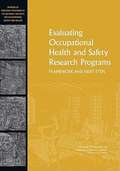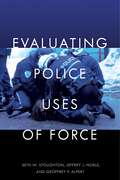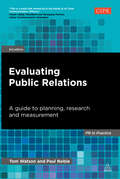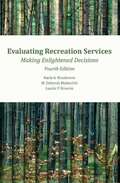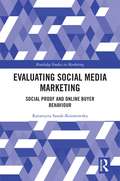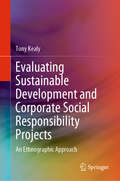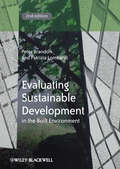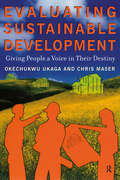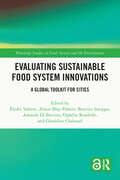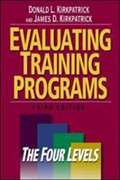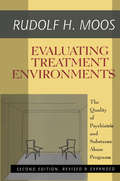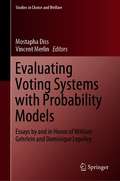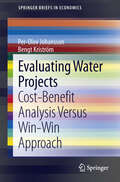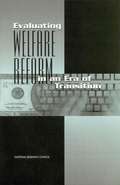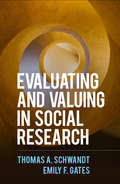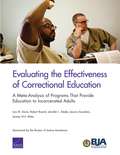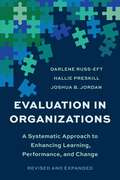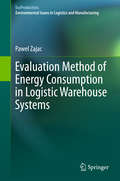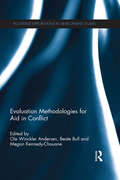- Table View
- List View
Evaluating Occupational Health and Safety Research Programs: Framework and Next Steps
by Institute of Medicine National Research Council of the National AcademiesEach year, approximately 5,000 fatal work-related injuries and 4 million non-fatal injuries and illnesses occur in the United States. This number represents both unnecessary human suffering and high economic costs. In order to assist in better evaluating workplace safety and create safer work environments, the Institute of Medicine conducted a series of evaluations of the National Institute for Occupational Safety and Health (NIOSH) research programs, assessing the relevance and impact of NIOSH's work on improving worker safety and health.
Evaluating Organization Development: How to Ensure and Sustain the Successful Transformation
by Maureen Connelly Jones William J RothwellEvaluating organization development (OD) and change is critical for any executive team, project manager, or consultant who wants to see the change effort sustain and successfully evolve. Evaluation can be the key to enacting real change that makes sense to the team, your customers, and your stakeholders while seeing your strategic plan make crucial differences. The process of evaluation is often missing from change initiatives, and many previous books have glossed over the topic, but Evaluating Organization Development: How to Ensure and Sustain the Successful Transformation makes planning, implementing, and then assessing your change efforts simple. With handy "how-to" lessons, pull-out tools that are ready to use, and case studies that guide the implementation of each step, your team will be able to show the impact and justify the resources for each project. In addition, your team benefits from this step-by-step guide because they too will now understand their role and be connected to meeting the challenge of each metric. When the team understands the goal and how to achieve it, everyone wins.
Evaluating Police Uses of Force
by Seth W. Stoughton Jeffrey J. Noble Geoffrey P. AlpertProvides a critical understanding and evaluation of police tactics and the use of forcePolice violence has historically played an important role in shaping public attitudes toward the government. Community trust and confidence in policing have been undermined by the perception that officers are using force unnecessarily, too frequently, or in problematic ways. The use of force, or harm suffered by a community as a result of such force, can also serve as a flashpoint, a spark that ignites long-simmering community hostility.In Evaluating Police Uses of Force, legal scholar Seth W. Stoughton, former deputy chief of police Jeffrey J. Noble, and distinguished criminologist Geoffrey P. Alpert explore a critical but largely overlooked facet of the difficult and controversial issues of police violence and accountability: how does society evaluate use-of-force incidents? By leading readers through answers to this question from four different perspectives—constitutional law, state law, administrative regulation, and community expectations—and by providing critical information about police tactics and force options that are implicated within those frameworks, Evaluating Police Uses of Force helps situate readers within broader conversations about governmental accountability, the role that police play in modern society, and how officers should go about fulfilling their duties.
Evaluating Public Relations
by Tom Watson Paul NobleOperating under tight budget constraints and with an ever increasing range of tools and technologies to choose from, PR professionals have never been under so much pressure to provide solid, meaningful results and to justify their decisions. Evaluating Public Relations advises PR practitioners at all levels on how to demonstrate clearly and objectively the impact that their work has to their clients and managers. The authors draw on both their practical and academic experience to discuss a diverse range of evaluation methods and strategies and this new edition includes full coverage and advice on the new industry standards on PR measurement. Covering both theory and practice, Evaluating Public Relations is an essential handbook for both students and experienced practitioners.
Evaluating Recreation Services: Making Enlightened Decisions
by Karla A. Henderson M. Deborah Bialeschki Laurie P. BrowneEvaluation is a process that each of us uses every day. Professionals in any field of human services must have the means to access and assess information. Having information is not enough, however, unless that information can be applied and used. To organize and manage recreation services (i.e., all elements related to the various specialties in the field such as parks, tourism, sports, arts, therapeutic recreation, camping, event management), information is needed about people's preferences, needs, and behaviors and the programs, administrative structures, and resources that comprise the organizations. To build a body of knowledge and to document the value of recreation, systematic processes are necessary. Evaluation and research can provide information that will enable ""enlightened decisions."" Evaluating Recreation Services: Making Enlightened Decisions, Fourth Edition, is about systematic evaluation and research that focuses specifically on identifying explicit evaluation criteria or research questions, collecting evidence or data, and making judgments about the value or the worth of something applied to service improvement or knowledge development. This book aims to provide a basic overview and working knowledge of procedures. Knowing basic steps in evaluation research and having some familiarity with evaluation and research tools can help you to begin a process of lifelong learning about systematic inquiry.
Evaluating Social Media Marketing: Social Proof and Online Buyer Behaviour (Routledge Studies in Marketing)
by Katarzyna Sanak-KosmowskaThis book is an innovative attempt to identify and analyse the processes related to social influence in online buying behaviour, with special attention given to the phenomenon of social proof, which is the basis of social media, recommendation marketing and word of mouth (WOM) marketing. It empirically verifies the factors which influence the effectiveness of social proof, as well as identifying relevant impact factors. Opening with a literature review of this concept from the perspective of social psychology, sociology and marketing, this interdisciplinary approach to the issue allows for an in-depth understanding of the mechanisms of the effective use of social proof in contemporary online marketing. Following this, in the context of theoretical considerations, the author analyses the social role and significance of social proof in the buying behaviours of online consumers. The second half of the book presents the results of the author’s quantitative and qualitative research of the effectiveness of social proof. The quantitative research verifies the hypotheses concerning the social role and significance of social proof in buying decisions and identifies the level of confidence in the opinions expressed by other web users. The qualitative research focuses on the empirical verification of the effectiveness of social proof mechanisms. Additionally, attention is given to sensitivity to social proof, i.e., the factors that increase the effectiveness of such messages, both from the sender’s and recipient’s perspective, as well as the forms and channels of communication. Written for scholars and researchers interested in the debate on the transparency of activities carried out by companies in the area of online marketing, the book’s detailed analysis of influence utilising both quantitative and qualitative studies may be of interest to a wider group of academics including economists, psychologists and sociologists.
Evaluating Sustainable Development and Corporate Social Responsibility Projects: An Ethnographic Approach
by Tony KealyThis book discusses sustainable development decision-making. Focusing on decisions to invest in wind turbine technology as part of a corporation’s CO2 emission reduction strategy, it presents a new evaluation framework, based on the triple bottom line framework widely used by businesses to communicate their adherence to corporate social responsibility. This new framework allows the evaluation of strategic corporate decisions to invest in wind turbines to mitigate global warming in the context of a corporation’s social responsibility, and includes an objective measurement stage to add rigor to the evaluation process. The book describes the use of measured data from wind turbine projects to both develop and validate the methodology, and also identifies key enablers and barriers as businesses attempt to successfully integrate corporate social responsibility into their overall business strategy. Given its scope, the book appeals to postgraduate students, researchers, and business professionals interested in the environmental impact of corporations. Featuring case studies from Ireland, it is particularly relevant to audiences within Europe.
Evaluating Sustainable Development in the Built Environment
by Patrizia Lombardi Peter BrandonThe first edition was extremely well received, providing an introduction and insight to this important topic in a comprehensive yet easy to read form. It was chosen to be issued to the representatives of the organizations from the G8 and G20 countries attending the University Summit held in Turin in 2009 which addressed the issue of how education and research can assist sustainable development. The second edition, completely updated to reflect the significant advances and new insights that have been made since publication of the first edition, focuses on two main issues:Facilitating a dialogue between all stakeholders so that the complexity of the problem can be exposed, structured and communicated Understanding how to assess progress in sustainable development It continues to provide coherent guidance on the techniques that can be used to assess sustainable development in a rigorous manner. The approach is introduced using illustrations and case studies, together with follow-up references. It remains the ideal starting point for those trying to get a handle on the subject and for those who wish to examine a structured and systematic approach to the evaluation of sustainable development in the built environment.
Evaluating Sustainable Development: Giving People a Voice in Their Destiny
by Chris Maser Okechukwu UkagaThis book presents the principles and the tools for participatory evaluation of sustainable development--growth that does not compromise the ability of future generations to meet their needs. It is intended for any citizen or group that may be concerned with protecting or recovering a cultural heritage, assessing the impact of a project or of plans that impact an environment or ecosystem.The authors describe participatory evaluation processes that will empower all interested "stakeholders"--anyone impacted by a proposed venture--to determine and control what is to be evaluated and how it is evaluated, to articulate and define their community’s vision, and to ensure that development plans meet their community’s needs sustainably. Acknowledging that the specific concepts, challenges, opportunities, and circumstances surrounding sustainable development differ significantly from one place or group to another, the authors provide an adaptable framework for developing an evaluation plan, as well as the tools for collecting, analyzing, interpreting and presenting data. They explain how to use and communicate findings to ensure a full and appropriate debate about the issues, and finally how to implement the evaluation plan.An important and practical book for anyone concerned with the impact of planning and development issues and who wants to ensure that all sectors of their community are given a voice in decisions that affect them.
Evaluating Sustainable Food System Innovations: A Global Toolkit for Cities (Routledge Studies in Food, Society and the Environment)
by Alison Blay-Palmer Élodie Valette Amanda Di Battista Beatrice Intoppa Ophélie Roudelle Géraldine ChaboudThis book presents URBAL, an approach that applies impact pathway mapping to understand how food system innovations in cities, and their territories, change and impact food system sustainability. Around the world, people are finding innovative ways to make their food systems more sustainable. However, documenting and understanding how these innovations impact the sustainability of food system can be a challenge. The Urban Driven Innovations for Sustainable Food Systems (URBAL) methodology responds to these constraints by providing innovations with a simple, open-source, resource-efficient tool that is easily appropriated and adaptable to different contexts. URBAL is designed to respond to the demands of field stakeholders, whether public or private, to accompany and guide them in their actions and decision-making with regard to sustainability objectives. This book presents this qualitative and participatory impact assessment method of food innovations and applies it to several cases of food innovation around the world, including the impact of agricultural districts in Milan, chefs and gastronomy in Brasilia, e-commerce in Vietnam, eco-friendly farm systems in Berlin and The Nourish to Flourish governance process in Cape Town. The book demonstrates how food innovations can impact different dimensions of sustainability, positively and negatively, and identify the elements that facilitate or hinder these impacts. The volume reflects on how to strengthen the capacity of these stakeholders to disseminate their innovations on other scales to contribute to the transition towards more sustainable food systems. This book will be of great interest to students and scholars working on sustainable food systems, urban food, food innovation and impact assessment, as well as policymakers, practitioners and funders interested in these areas.
Evaluating Training Programs: The Four Levels (3rd edition)
by Donald L. Kirkpatrick James D. KirkpatrickIn this manual, the authors provide a model for evaluating training programs based on four levels: reaction, learning, behavior, and results. The book is supplemented with sample survey forms and includes actual case studies from various organizations which allow the reader to apply them to different types of training. This third edition includes a new chapter on e-learning as well as eleven new case studies. Implementing the results of the evaluations is a focus. An index is included. Annotation ©2006 Book News, Inc., Portland, OR (booknews.com)
Evaluating Treatment Environments: The Quality of Psychiatric and Substance Abuse Programs
by Rudolf H. MoosEvaluating Treatment Environments describes how to assess the quality of psychiatric and substance abuse programs and how to use that information to monitor and improve these programs. Its aim is to identify environments that promote opportunities for personal growth, simultaneously enhancing both physical and psychological well-being. Although treatment programs are diverse, Moos asserts that a common conceptual framework can be used to evaluate them, and more emphasis should be placed on the process of matching personal and program factors and on the connections between such matches and patients' outcomes.The book is divided into three main parts. Part I focuses on hospital programs, using a sample of 160 programs throughout the United States. Part II evaluates community programs. Moos describes how to monitor and improve these programs, and assesses program implementation. Part III considers treatment environments, examining factors that shape the treatment environment, patients' satisfaction with and participation in program activities, patients' adaptation and community living skills, and patient-program congruence and the influence of treatment environments on patients with different levels of impairment. It also highlights the importance of the health care workplace and its impact on staff and the treatment environment.Treatment programs vary substantially in their policies and services, especially in what they expect of clients, rules about clients' daily life choices, and to what extent clients must be governed by the program, and whether or not the programs provide health and treatment services. Comparison studies are becoming more important as clients move more quickly from acute in-patient to community residential care. Moos stresses the need to pay special attention to how programs and services affect clients when conducting evaluations. Evaluating Treatment Environments will be a necessary addition to the libraries of mental health service professionals, as well as sociologists, psychiatrists, psychologists, and social workers.
Evaluating Voting Systems with Probability Models: Essays by and in Honor of William Gehrlein and Dominique Lepelley (Studies in Choice and Welfare)
by Mostapha Diss Vincent MerlinThis book includes up-to-date contributions in the broadly defined area of probabilistic analysis of voting rules and decision mechanisms. Featuring papers from all fields of social choice and game theory, it presents probability arguments to allow readers to gain a better understanding of the properties of decision rules and of the functioning of modern democracies. In particular, it focuses on the legacy of William Gehrlein and Dominique Lepelley, two prominent scholars who have made important contributions to this field over the last fifty years. It covers a range of topics, including (but not limited to) computational and technical aspects of probability approaches, evaluation of the likelihood of voting paradoxes, power indices, empirical evaluations of voting rules, models of voters’ behavior, and strategic voting. The book gathers articles written in honor of Gehrlein and Lepelley along with original works written by the two scholars themselves.
Evaluating Water Projects
by Per-Olov Johansson Bengt KriströmShould more water be diverted to or from electricity generation? This timely question is addressed in this short volume. Two different approaches are introduced and compared: The first is a cost-benefit analysis, examining the case of re-regulating a Swedish hydropower plant in which water is diverted from electricity generation to the downstream dryway. The proposed scenario generates environmental and other benefits, but comes at a cost in terms of lost electricity. The second study introduces an approach very different from the one used in conventional cost-benefit analysis, and provides a set of measures designed so that most, if not all, affected parties will be better off. Thus, in contrast to a conventional cost-benefit analysis, which draws on hypothetical compensation measures, the new approach envisages actual compensation. Comparing two different theoretical frameworks on the basis of a real-world case, this study can be seen as a manual that can be used to evaluate reasonably small re-regulation of rivers.
Evaluating Welfare Reform in an Era of Transition
by Institute of MedicineReform of welfare is one of the nation's most contentious issues, with debate often driven more by politics than by facts and careful analysis. Evaluating Welfare Reform in an Era of Transition identifies the key policy questions for measuring whether our changing social welfare programs are working, reviews the available studies and research, and recommends the most effective ways to answer those questions.This book discusses the development of welfare policy, including the landmark 1996 federal law that devolved most of the responsibility for welfare policies and their implementation to the states. A thorough analysis of the available research leads to the identification of gaps in what is currently known about the effects of welfare reform.Evaluating Welfare Reform in an Era of Transition specifies what-and why-we need to know about the response of individual states to the federal overhaul of welfare and the effects of the many changes in the nation's welfare laws, policies, and practices.With a clear approach to a variety of issues, Evaluating Welfare Reform in an Era of Transition will be important to policy makers, welfare administrators, researchers, journalists, and advocates on all sides of the issue.
Evaluating an Action Plan
by Linda A. HillManagers report that action planning to resolve interpersonal and organizational challenges is far more demanding than diagnosing them. Although there are many frameworks for evaluating their diagnoses, there are few for evaluating their action plans. Reviews the major criteria for assessing an action plan. Includes a short list of "Key Elements of Action Planning," and a longer list of "Criteria for Evaluating an Action Plan." The list of criteria is written as a series of questions to ask yourself when assessing an action plan.
Evaluating and Valuing in Social Research
by Thomas A. Schwandt Emily F. GatesMuch applied research takes place as if complex social problems--and evaluations of interventions to address them--can be dealt with in a purely technical way. In contrast, this groundbreaking book offers an alternative approach that incorporates sustained, systematic reflection about researchers' values, what values research promotes, how decisions about what to value are made and by whom, and how judging the value of social interventions takes place. The authors offer practical and conceptual guidance to help researchers engage meaningfully with value conflicts and refine their capacity to engage in deliberative argumentation. Pedagogical features include a detailed evaluation case, "Bridge to Practice" exercises and annotated resources in most chapters, and an end-of-book glossary.
Evaluating the Effectiveness of Correctional Education: A Meta-Analysis of Programs That Provide Education to Incarcerated Adults
by Lois M. Davis Jessica Saunders Jennifer L. Steele Jeremy N. V. Miles Robert BozickAfter conducting a comprehensive literature search, the authors undertook a meta-analysis to examine the association between correctional education and reductions in recidivism, improvements in employment after release from prison, and other outcomes. The study finds that receiving correctional education while incarcerated reduces inmates' risk of recidivating and may improve their odds of obtaining employment after release from prison.
Evaluating the Financial Performance of Pension Funds
by Juan Yermo Pablo Antolín Richard Hinz Rudolph HeinzCountries around the world are increasingly relying on individual pension savings accounts to provide income in old age for their citizens. Although these funds have now been in place for several decades, their performance is usually measured using methods that are not meaningful in relation to this long-term objective. The recent global financial crisis has highlighted the need to develop better performance evaluation methods that are consistent with the retirement income objective of pension funds. Compiling research derived from a partnership among the World Bank, the Organisation for Economic Co-operation and Development (OECD), and three private partners, 'Evaluating the Financial Performance of Pension Funds' discusses the theoretical basis and key implementation issues related to the design of performance benchmarks based on life-cycle savings and investment principles. The book begins with an evaluation of the financial performance of funded pension systems using the standard mean variance framework. It then provides a discussion of the limitations inherent to applying these methods to pension funds and outlines the many other issues that should be addressed in developing more useful and meaningful performance measures through the formulation of pension-specific benchmark portfolios. Practical implementation issues are addressed through empirical examples of how such benchmarks could be developed. The book concludes with commentary and observations from several noted pension experts about the need for a new approach to performance measurement and the impact of the recent global financial crisis on pension funds.
Evaluation In Organizations: A Systematic Approach To Enhancing Learning, Performance, And Change
by Darlene Russ-Eft Hallie Preskill Joshua B. JordanTake control of your resources and get the most out of your work with this helpful guide to organization and productivity From new product launches to large-scale training initiatives, organizations need the tools to measure the effectiveness of their programs, processes, and systems. In the third edition of Evaluation in Organizations, learning theory and evaluation experts Darlene Russ-Eft, Hallie Preskill, and Joshua B. Jordan integrate the most current research with practical application to provide the definitive resource on organizational evaluation for managers, human resource professionals, students, and teachers. From designing surveys and interviews to analyzing data to communicating results, the authors present a systematic and rigorous approach to conducting evaluations and using them to foster learning and enhance performance at all levels. Fully revised and updated to reflect new developments in the field, this comprehensive new edition of Evaluation in Organizations is designed to be accessible to as many different learning styles as possible.
Evaluation Management: How to Commission and Conduct Evaluations that Matter
by Anastasia (Tessie) Catsambas E. Jane DavidsonEvaluation Management: How to Commission and Conduct Evaluations that Matter helps evaluation teams and commissioners achieve results that meet utilization and organizational learning goals and inform positive change for programs and communities. Tessie Tzavaras Catsambas and E. Jane Davidson provide insights on both the tactical and strategic levels of evaluation management, using approaches and skills from project management, administration and logistics, budgeting, team management, leadership development, communication, coaching, systems thinking, and negotiation. They also demonstrate how intentionality for equity, sustainability and culturally responsive practices is essential for ensuring an evaluation’s relevance and enhancing productive stakeholder engagement. With plenty of practical guidance from many years of experience, the authors provide a valuable resource for student readers, experienced evaluators, and commissioners of evaluation.
Evaluation Management: How to Commission and Conduct Evaluations that Matter
by Anastasia (Tessie) Catsambas E. Jane DavidsonEvaluation Management: How to Commission and Conduct Evaluations that Matter helps evaluation teams and commissioners achieve results that meet utilization and organizational learning goals and inform positive change for programs and communities. Tessie Tzavaras Catsambas and E. Jane Davidson provide insights on both the tactical and strategic levels of evaluation management, using approaches and skills from project management, administration and logistics, budgeting, team management, leadership development, communication, coaching, systems thinking, and negotiation. They also demonstrate how intentionality for equity, sustainability and culturally responsive practices is essential for ensuring an evaluation’s relevance and enhancing productive stakeholder engagement. With plenty of practical guidance from many years of experience, the authors provide a valuable resource for student readers, experienced evaluators, and commissioners of evaluation.
Evaluation Method of Energy Consumption in Logistic Warehouse Systems
by Pawel ZajacThis book focuses on guidelines for reducing the energy consumption in warehousing processes. It presents a model of formal assessment for energy consumption in the context of storage-system logistics, as well as a computational model consisting of three sub-models: energy consumption models for forklifts and stacker cranes, respectively, and an energy intensity model for roller conveyors. The concept model is based on the assumption that the unit load is received at a zero-energy warehouse. Subsequent handling, transport and storage processes, in which the unit load is moved vertically and horizontally through the system, equate to changes in energy intensity within the logistics warehouse management system. Energy recovery based on the handling equipment used can be collected in batteries. The evaluation method takes into account the intensity of the energy supplied to the logistics system and reduces the storage of the recovered energy - this figure represents the energy needed to pass through the logistics unit load storage system, and can be expressed in an energy intensity map.
Evaluation Methodologies for Aid in Conflict (Routledge Explorations in Development Studies)
by Ole Winckler Andersen Beate Bull Megan Kennedy-ChouaneKnowledge and rigorous evidence around the role of external development partners in situations of conflict and fragility is still lacking. There is little accountability for the billions in aid being spent in places like Afghanistan, Iraq and the Democratic Republic of Congo. This book analyses evaluation theory and practice in order to help fill this knowledge gap and advocates a realistic and rigorous approach to evaluating international engagement. Through a series of case studies, this book highlights both the promise, and potential pitfalls, of taking a more evaluative approach to understanding aid in conflict regions. These illustrate the methodological and analytical approach taken by researchers working to understand the results and effectiveness of conflict prevention and peacebuilding support. While well-grounded in current theoretical and methodological debates, the book provides valuable practical information by examining how and why different choices were made in the context of each evaluation. The book shows what future steps may be envisaged to further strengthen evaluations of support for conflict prevention and peacebuilding. The analysis draws on a wealth of perspectives and voices to provide researchers and students in development studies and conflict and peace studies as well as development evaluators with a deep and broad understanding of evaluation methods and approaches.
Evaluation Platform of Sustainability for Global Systems: Statistical Approach to Geospatial Information for Big Data Integration
by Aki-Hiro Sato Hiroe TsubakiThe authors of this book assert that Grid Square statistics, a method of aggregating data within a geographically defined Grid, may be an effective solution to approach geospatial data for big data integration. Grid Square statistics is a technique that allows us to collect and analyze data based on Grids and makes it easier to understand patterns and trends. Sustainability, a key concern for the future of our society, often involves balancing multiple independent objectives. These objectives and key performance indicators must be shared to solve multi-dimensional optimization problems with some constraints related to sustainability issues. However, many of these sustainability issues are challenges that are part of global systems, which are modeled as a complex system consisting of many components. Social, economic, and environmental aspects in our socio-economic systems require solutions designed for the sustainability of our society. These conditions imply that Big Data must contribute to evaluating our current situation, actions, and changes to continuously change our behavior and society based on a Plan-Do-Check-Action (PDCA) cycle. The PDCA cycle, also known as the Deming cycle, is a four-step management method used to improve processes and products continuously. We must understand how to construct a platform by using Big Data to do so. Thus, extracting meaningful information from Big Data is crucially important in the advanced information society. This book provides case studies based on Grid Square statistics. It shows their applications to socio-economic and environmental problems such as tourism, where we analyze visitor patterns to optimize resource allocation, SDGs indicator, where we monitor the sustainability of our socio-economic systems, and disaster management, where we face natural disaster to enhance preparedness. Finally, the book proposes a World Grid Square Statistics Reference Architecture for constructing data applications across organizations and domains and reports on design concepts, system architecture, and the implication of a data platform for World Grid Square data and statistics.
